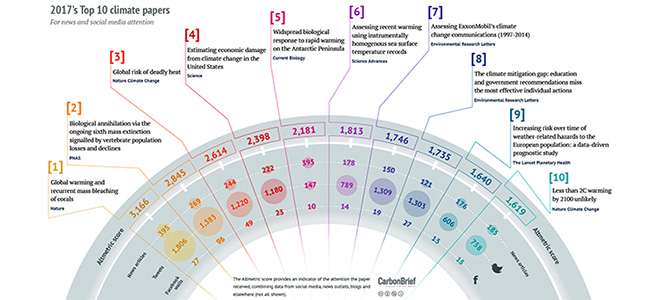
Max Boykoff’s MeCCO work for Lancet Report highlighted in Carbon Brief
Carbon Brief, January 24, 2018
Every day, dozens of scientific journals publish new climate change research that is shared across the world via the internet.
These journal papers make headlines in news articles and on blog pages, they pop up in Twitter timelines and on Facebook. But which ones make the biggest impression? Which have been shared and reported most widely?
Carbon Brief has compiled its annual list of the 25 most talked-about climate change-related papers of the previous year. The infographic above shows which ones made it into the Top 10 in 2017.
Our analysis is based on the data collected by Altmetric, which tracks and scores journal papers by the number of times they’re mentioned in online news articles and on social media platforms. (You can read more about how the Altmetric scoring system works in an earlier article.)
First place
The most widely reported and shared article related to climate change last year was actually a “Policy Forum” commentary in the journal Science. Published in mid-January, “The irreversible momentum of clean energy” was covered by 232 news articles and tweeted more than 9,000 times. Its overall Altmetric score of 7,872 means it is the highest ranked of any article published last year.
This paper was the 30th most talked about of all journal articles published last year. It was picked up by 395 news stories in 245 outlets – including the Guardian, Washington Post, CNN, MailOnline and the New York Times (both as a news article and in an editorial). It was also referenced in 1,806 tweets – more than any other paper in our Top 25 – 47 blog posts and on 27 public Facebook pages.
This is no surprise, perhaps, considering the author was Barack Obama, who, at the time, was still the US president. But as the article is a commentary, it does not make it into Carbon Brief’s leaderboard of research papers.
Instead, first place goes to, “Global warming and recurrent mass bleaching of corals”, a Nature paper published in March, with a score of 3,166.
The study, led by Prof Terry Hughes of the ARC Centre of Excellence for Coral Reef Studies in Australia, assessed the impact of coral bleaching events in 1998, 2002 and 2016 on the Great Barrier Reef. As Carbon Brief reported, the study concluded that “immediate global action to curb future warming” is essential if coral reefs are to survive.
The Top 5
Coming second is, “Biological annihilation via the ongoing sixth mass extinction signaled by vertebrate population losses and declines”, published in the Proceedings of the National Academy of Sciences of the United States of America (or “PNAS” for short) with an Altmetric score of 2,845.
The study, led by Dr Gerardo Ceballos of the National Autonomous University of Mexico, found that the Earth’s “sixth mass extinction” is well underway and has “proceeded further than most assume”.
Analysing nearly half of the Earth’s known vertebrate species, the researchers concluded that “habitat loss, overexploitation, invasive organisms, pollution, toxification, and more recently climate disruption” have led to “catastrophic declines in both the numbers and sizes of populations of both common and rare vertebrate species”.
The paper was tweeted 1,583 times and covered by 269 news stories, including in the Atlantic, Sun, Guardian, USA Today, CNN and the Washington Post. It was also posted on 96 Facebook pages, giving the paper the highest score for Facebook of any in the Top 25.
Taking third place with a score of 2,614 is the Nature Climate Change paper, “Global risk of deadly heat”, by lead author Dr Camilo Mora from the University of Hawai’i.
As Carbon Brief reported back in June, the study suggested that up to three quarters of the world’s population could be at risk from deadly heat extremes by the end of the century if global greenhouse gas emissions are not curbed.
The research garnered headlines in 244 news stories from 191 outlets, including Le Monde, the Independent, Der Spiegel and the Huffington Post – and an editorial in Nature. It was tweeted 1,220 times and posted 49 times on Facebook.
The study also appears to have been quoted frequently in later news articles on heatwaves, such as these pieces in the MailOnline, Business Insider and Vice.
Completing the Top 5 are, “Estimating economic damage from climate change in the United States”, in Science, by lead author Dr Solomon Hsiang of the University of California at Berkeley and researchers at the Climate Impact Lab and, “Widespread Biological Response to Rapid Warming on the Antarctic Peninsula”, in Current Biology, led by Dr Matt Amesbury of the University of Exeter.
The latter study generated the same number of news stories at the first placed paper (395), but was tweeted just 147 times – the third lowest total of the Top 25. Interestingly, the Altmetric scores of both papers are more than 2,000, which would have put them second place in Carbon Brief’s 2016 list and first in the 2015 one.
Elsewhere in the Top 10
Just missing out on the Top 5 is, “Assessing recent warming using instrumentally homogeneous sea surface temperature records”, published in Science Advances, in sixth place.
The paper’s lead author is Carbon Brief’s US analyst Zeke Hausfather. The study, published in early January before Hausfather joined Carbon Brief, uses the latest sea surface temperature (SST) data to see which of the major global temperature datasets best captures the rate of warming in recent decades.
As Carbon Brief reported at the time, the study found that National Oceanic and Atmospheric Administration’s (NOAA) most recent dataset matched Hausather’s record closely, and that the other datasets underestimated recent warming.
While the study generated a substantial amount of news coverage when it was published, it received a subsequent bounce when NOAA’s SST record became the centre of an alleged “whistleblower” article in the Mail on Sunday, which accused NOAA of manipulating climate data to show more warming in recent years.
As Hausfather explained in a guest post for Carbon Brief, NOAA’s data had been independently verified by his Science Advances study and the Mail on Sunday’s piece “in no way changes our understanding of modern warming or our best estimates of recent rates of warming”.
Multiple responses to the Mail on Sunday article brought another flurry of news articles, including in the Washington Post, New York Times and, ironically, in an Associated Press article that was reposted by the MailOnline.
(The Independent Press Standards Organisation subsequently ruled that the Mail on Sunday article was “significantly misleading” and required the newspaper to publish a correction.)
The Top 10 also includes, “Assessing ExxonMobil’s climate change communications (1977–2014)”, published in Environmental Research Letters by Dr Geoffrey Supran and Prof Naomi Oreskes of Harvard University.
The study, coming in seventh place, found that ExxonMobil contributed to advancing climate science through its scientific publications, while simultaneously promoting doubt in paid, editorial-style advertisements in the New York Times. The conclusion that ExxonMobil “misled the general public” on climate change was reported in many major news outlets.
Completing the Top 10 is, “Less than 2C warming by 2100 unlikely”, in Nature Climate Change by lead author Prof Adrian E Raftery from the University of Washington.
The study used statistical forecasts to show there is a 5% chance of keeping global warming to less than 2C above pre-industrial levels this century – and just 1% of staying below 1.5C. This stark conclusion was reported in 185 news articles last year.
Honourable mentions
As our list of the most talked about climate papers in 2017 comprises 25 articles, here are a few honourable mentions of those that fall outside the Top 10.
In 11th place is, “The Lancet Countdown on health and climate change: from 25 years of inaction to a global transformation for public health”, published – unsurprisingly – in the Lancet.
The paper is from a Lancet project involving 24 academic institutions and intergovernmental organisations from across the world. It will release a report tracking progress on climate change and global health every year, of which this is the first.
As Carbon Brief reported from the study’s press conference, the authors said the effect of climate change on human health is now so severe that it should be considered “the major threat of the 21st century”. Read more …
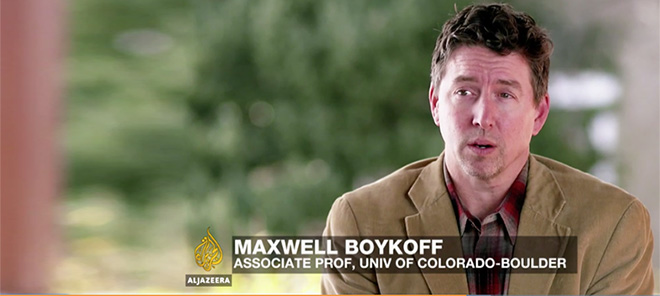





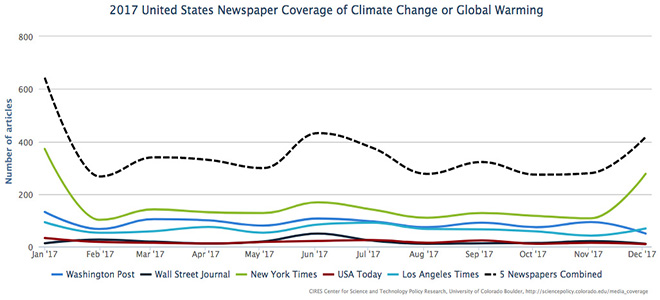 The prominence of news on climate change or global warming associated with Donald J. Trump in 2017 has been referred to as a ‘Trump Dump’. This is defined as a phenomena where media attention that would have focused on other climate-related events and issues instead was placed on Trump-related actions, leaving many other stories untold.
The prominence of news on climate change or global warming associated with Donald J. Trump in 2017 has been referred to as a ‘Trump Dump’. This is defined as a phenomena where media attention that would have focused on other climate-related events and issues instead was placed on Trump-related actions, leaving many other stories untold.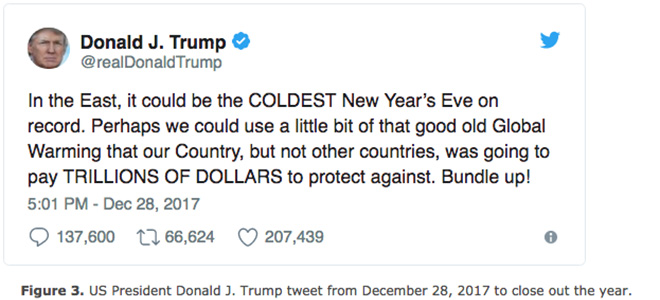
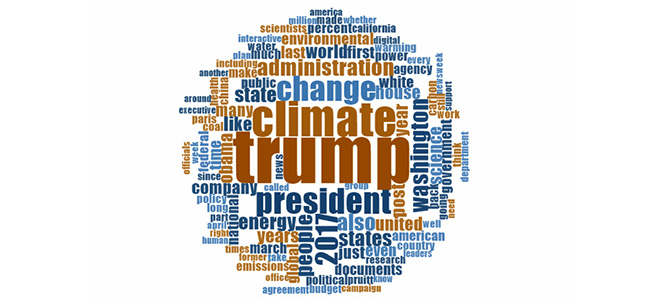
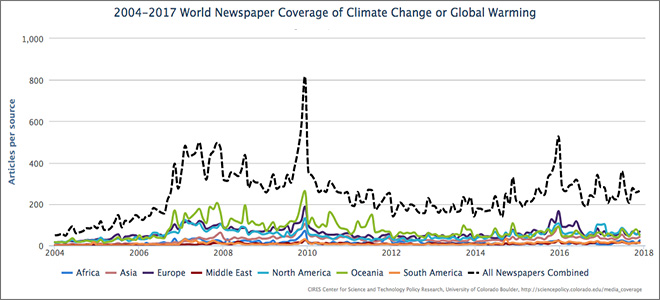
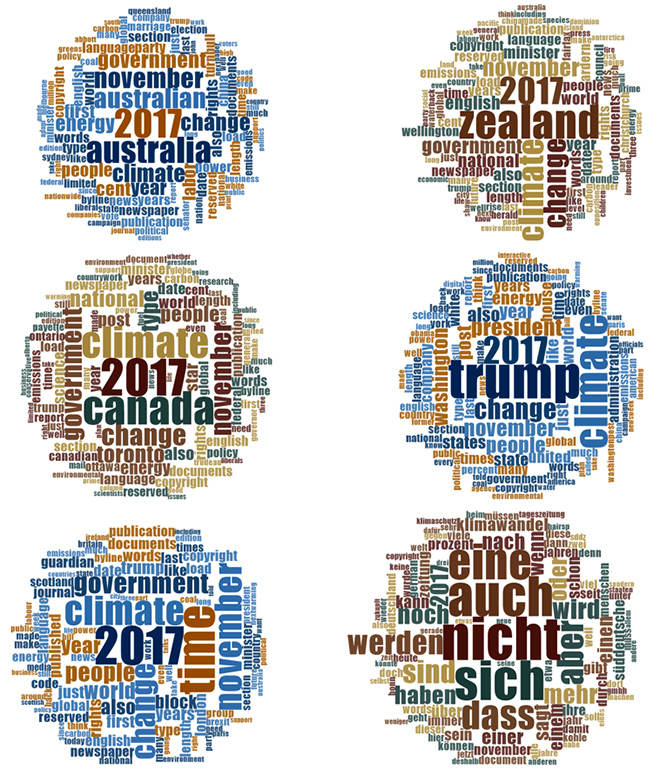
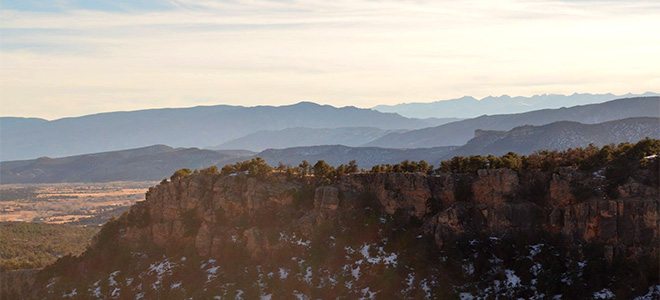
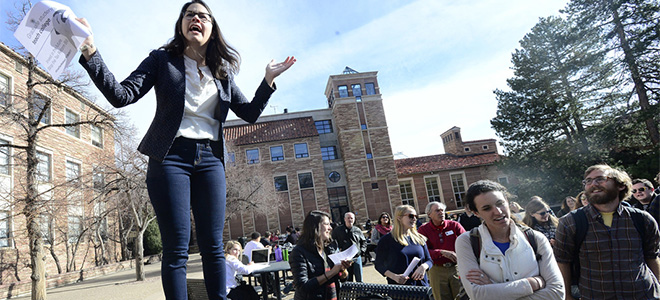


Flood Modelling and Assessments for Downstream Communities of Koka Dam, Ethiopia
Prepared by Katherine Chambers
2017 Red Cross Red Crescent Climate Centre Internship Winner
Katie is a PhD student in Environmental Engineering with a focus on Engineering for Developing Communities. In Ethiopia, Katie developed flood inundation maps for communities downstream of hydroelectric dams. These maps will guide the development of Early Warning Early Action frameworks for the Ethiopian Red Cross Society and IFRC. Her environmental engineering research investigates the comparative vulnerabilities and resilience of different types of sanitation systems found in resource-limited communities, as well as the tradeoffs made when prioritizing resilience in system selection.
The following report presents the findings of the author’s research from May to August 2017 with support from the International Federation of Red Cross and Red Crescent Societies; Ministry of Water, Irrigation and Electricity – Ethiopia; Ethiopian Red Cross Society; and Red Cross Red Crescent Climate Centre (Climate Centre). The study area was Koka Dam and its downstream communities, located in the Oromia Region of Ethiopia. The study’s objectives were to (1) identify forecasts of natural phenomena that can help anticipate flood events; (2) assess what is known and what needs to be known to link forecasts with anticipated impacts; (3) suggest actions worth taking as soon as the forecast exceeds a predefined threshold of risk; and (4) outline proposed next steps for a forecast-based contingency plan. The author used the flood modelling software HEC-GeoRAS and community assessments iteratively to achieve the objectives.
Flood modelling was performed using HEC-GeoRAS, a software developed by the United States Army Corps of Engineers. The program allows users to view modelling results geospatially to determine the extent of flooding along a river or stream. The results from the HEC-GeoRAS analysis showed that agricultural land is the most vulnerable area to flooding. Therefore, minimizing flood impacts would improve the livelihoods of the agricultural workers living alongside the river by reducing damage to their land.
Following preliminary flood modelling, community assessments were performed in seven communities and two facilities downstream of Koka Dam. Focus groups were organized to elicit information. The results of the assessments showed that each community and facility suffers from flooding. The primary consequence of flooding is the destruction of agricultural lands, which confirmed the modelled results. Farming is the primary income-generating activity in the interviewed communities, and communities expressed a strong desire to improve flood management to improve their earning capacity. In addition to loss of income, communities reported an increase in the number of malaria and acute watery diarrhea cases following floods. Minimizing flood impacts can improve the livelihoods and health of the communities living downstream of Koka Dam.
Perceptions on the existing early warning system (run by the Awash Basin Authorities) were also elicited from community assessments. Communities are notified via media (e.g., television, radio) about scheduled releases from Koka Dam, while Sodere and Wonji are notified via phone calls and in-person meetings. Suggestions from communities for improving the existing warning mechanism included in-person notification, mobile phone calls, SMS messages, or notification of local irrigation officers. Representatives from Sodere and Wonji were satisfied with the existing warning mechanisms. Suggestions from communities, Sodere, and Wonji to improve the existing warning content included earlier warnings and details on the predicted impacts of flooding.
Recommended next steps for the project include exploring the feasibility of FUNES implementation and continuously engaging with the project’s stakeholders. FUNES is a self-learning algorithm software for hydropower dams developed by the Climate Centre. It was successfully piloted in Togo in 2016. The software uses hydrologic and precipitation data to improve flood predictions and the timing of controlled releases to minimize flood impacts to downstream communities of hydroelectric dams. The existing mechanism for controlled releases from Koka Dam is to simply release water from the reservoir when it reaches a certain level, and the downstream communities suffer from regular inundation of agricultural lands. In the future, FUNES could be implemented to better time controlled releases to minimize flood impacts and improve livelihoods in these communities. To ensure the successful implementation of the software, the project’s stakeholders should remain continually engaged. The project stakeholders include both government organizations and Red Cross affiliates. Read more …